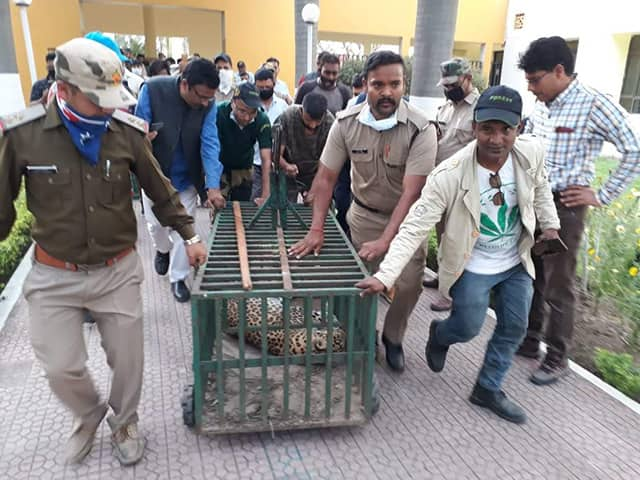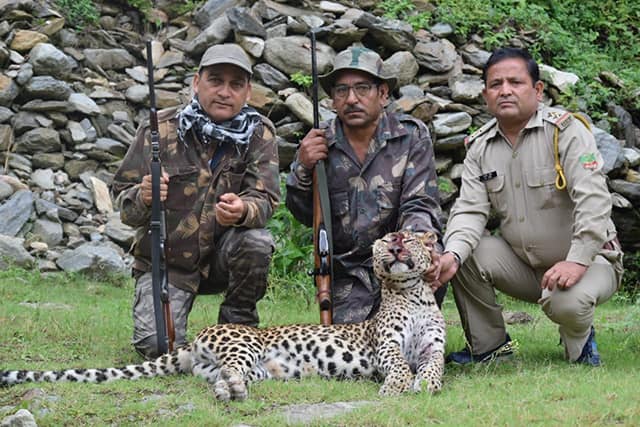Dehradun: Over half a dozen villages in the Chinyalisaur block of Uttarkashi district are reeling under the fear of a man-eating leopard for the past one and a half months. The feline has created terror in the area by killing two women and injuring two others, instilling panic among the villagers. The presence of a man-eating leopard has profoundly impacted the social and economic fabric of the villagers, as evidenced by the current situation in Mani, Bhadkot, Tulyada, Anol, Baadshai, and Malli Badan villages. Following the harrowing mauling of 45-year-old Bhagrithi Devi by the leopard in Bhadkot village on 16 June, an atmosphere akin to a curfew has gripped the region. Fear has enveloped the minds of children, dissuading them from attending school, while farmers venture out to the fields in groups for safety. Women from the village cautiously gather fodder from nearby areas, avoiding any foray into the forest. Even the slightest hint of movement startles the locals, leaving them on edge. Shivraj Singh Bisht, Pradhan of Bhadkot village, rues, “The villagers are afraid of going to their agriculture fields. Their livelihood depends on agriculture and animal husbandry. The work remains badly affected as the locals are living in great fear and not even going to the forest to collect fodder.” [caption id=“attachment_12839102” align=“alignnone” width=“640”] Bhadkot village. Image courtesy Raju Gusain [/caption] In response to the lurking danger posed by the man-eating leopard, the villagers have been compelled to alter their daily routines. They now venture into their agricultural fields later in the day and return home early, significantly reducing the time dedicated to farming activities. Despite being aware of the adverse impact on their production, the locals find themselves with limited options, as risking their lives is out of the question. In several regions of the Chinyalisaur block, paddy transplantation work has been completed, but the crucial task of de-weeding the Koda (rice grass) and Jhangora (Indian barnyard millet) fields has suffered immensely due to the presence of this formidable feline in various areas. The de-weeding from Koda (rice grass) and Jhangora (Indian barnyard millet) fields have suffered badly due to the dangerous feline active in different areas. After the Bhadkot village incident, the local people lost their patience. Following the unsettling incident in Bhadkot village, the patience of the local community wore thin. A team from the forest department arrived at the affected area, only to be confronted by the intense anger of the villagers. The prevailing sentiment among the villagers compelled the Uttarakhand forest department to officially classify the leopard as a man-eater, leading to the deployment of a specialized team of shooters. Divisional Forest Officer (Uttarkashi) Devi Prasad Balooni says, “Two Rapid Response Teams are patrolling in the affected area. We are closely monitoring the situation.” The leopard came into the limelight by killing Sunita Devi (32) in the village of Mani on 13 May. The feline killed Bhagirathi Devi (45) at Bhadkot on 16 June affecting everyday life in many villages of Chinyalisaur block in Uttarkashi. Bhadkot is a big village with a population of about a thousand people, with about 150 houses. Reports of leopard sightings are recorded from different areas. With the villagers actively using social media, the news about the new sighting instantly spreads in the affected areas. This too has forced the locals to maintain extra security and remain in safer locations. Pramod Rawat, a resident of Anol, says, “My village is close to Bhadkot and we are receiving reports of leopard sightings regularly. Those who can afford, are sending their children to school on a vehicle to Chinyalisaur. Many are not sending their kids to school due to the grave situation. The parents of the students, who undertake a walk to reach their schools, remain anxious till their ward returns home.” As the villages see any leopard they rush to safer locations and alert others. This has become routine in many affected villages. Rajveer Tamta, a resident of Baadshai village says, “The villagers are leading a miserable life. We hear the leopard’s roar from the area near Pani Khala on a regular interval. We don’t know when things will turn normal.” The enduring issue of man-animal conflict in Uttarakhand paints a distressing picture, as indicated by the data compiled by the state forest department. Among all instances of man-animal conflicts, leopards have emerged as a significant contributor. Over the past 23 years, from 2000 to 16th June 2023, more than 500 individuals have tragically lost their lives as a result of leopard attacks in Uttarakhand. Additionally, during the same period, another 1,834 people suffered grave injuries due to encounters with leopards. According to the Uttarakhand forest department’s wildlife census (2008), there are a total of 2,335 leopards in Uttarakhand - 593 in the protected area and 1,742 others outside the protected area. But, field staff of the forest department feel that the number of leopards is much higher in the state. [caption id=“attachment_12839112” align=“alignnone” width=“640”]
 (File) Forest staff moving the leopard in a cage from a school in Rishikesh in 2020. Image courtesy Raju Gusain[/caption] Whenever any man-eater becomes active the forest department deploys specialized shooters. However, the National Tiger Conservation Authority has recently revised its regulations, implementing stringent guidelines. These updated norms restrict the execution of operations to eliminate man-eaters solely to authorized personnel from the forest department and government servants. Renowned shooter Joy Hukil, who has shot down 44 man-eater leopards, says, “The scene is alarming. In simple words I can say that there is room for two and one dozen are there.” In 2018, the National Tiger Conservation Authority and the Wildlife Institute of India released a report – ‘Status of leopards, co-predators, and megaherbivores in India’. The study places Uttarakhand in the fifth spot in the leopard population in India. Madhya Pradesh leads the table with 3,421 leopards, followed by Maharashtra with 1,690, Tamil Nadu with 868, Chhattisgarh with 852 and Uttarakhand with 839 leopards. The data of the state forest department and NTCA vary as the census was conducted in protected areas only. Making a note on Uttarakhand, the leopard statues report states, “A total of 10 sites were camera trapped in Uttarakhand that yielded 2,594 photo captures of 517 leopard individuals. As mentioned earlier, we only report leopard numbers from potential tiger habitats in the state. The leopard population of the state was 839.” Despite the absence of a comprehensive statewide study on leopards, reports of human casualties and injuries resulting from leopard attacks consistently grab newspaper headlines. Individuals residing beyond the confines of protected areas find themselves grappling with the relentless and dangerous man-animal conflict, endangering their lives. On the reasons for the growing man-leopard conflict, shooter Lakhapat Rawat, who has killed 53 man-eater leopards and two tigers, says, “The population of leopards have increased manifold and there is the reduction in their prey base. We have even witnessed leopards living in a group like lions. This is a dangerous trend. Mass migration hits most villages, and the abandoned houses provide safe dwelling/hiding places for the leopards.” [caption id=“attachment_12839132” align=“alignnone” width=“640”]
(File) Forest staff moving the leopard in a cage from a school in Rishikesh in 2020. Image courtesy Raju Gusain[/caption] Whenever any man-eater becomes active the forest department deploys specialized shooters. However, the National Tiger Conservation Authority has recently revised its regulations, implementing stringent guidelines. These updated norms restrict the execution of operations to eliminate man-eaters solely to authorized personnel from the forest department and government servants. Renowned shooter Joy Hukil, who has shot down 44 man-eater leopards, says, “The scene is alarming. In simple words I can say that there is room for two and one dozen are there.” In 2018, the National Tiger Conservation Authority and the Wildlife Institute of India released a report – ‘Status of leopards, co-predators, and megaherbivores in India’. The study places Uttarakhand in the fifth spot in the leopard population in India. Madhya Pradesh leads the table with 3,421 leopards, followed by Maharashtra with 1,690, Tamil Nadu with 868, Chhattisgarh with 852 and Uttarakhand with 839 leopards. The data of the state forest department and NTCA vary as the census was conducted in protected areas only. Making a note on Uttarakhand, the leopard statues report states, “A total of 10 sites were camera trapped in Uttarakhand that yielded 2,594 photo captures of 517 leopard individuals. As mentioned earlier, we only report leopard numbers from potential tiger habitats in the state. The leopard population of the state was 839.” Despite the absence of a comprehensive statewide study on leopards, reports of human casualties and injuries resulting from leopard attacks consistently grab newspaper headlines. Individuals residing beyond the confines of protected areas find themselves grappling with the relentless and dangerous man-animal conflict, endangering their lives. On the reasons for the growing man-leopard conflict, shooter Lakhapat Rawat, who has killed 53 man-eater leopards and two tigers, says, “The population of leopards have increased manifold and there is the reduction in their prey base. We have even witnessed leopards living in a group like lions. This is a dangerous trend. Mass migration hits most villages, and the abandoned houses provide safe dwelling/hiding places for the leopards.” [caption id=“attachment_12839132” align=“alignnone” width=“640”] (File) Hunters Lakhapat Rawat & Joy Hukil after eliminating a man-eater leopard in 2020. Image courtesy Raju Gusain
(File) Hunters Lakhapat Rawat & Joy Hukil after eliminating a man-eater leopard in 2020. Image courtesy Raju Gusain
[/caption] In the hill state, numerous individuals have tragically perished or suffered severe injuries due to leopard attacks. The alarming situation has instilled fear among the locals, who directly attribute it to the conservation practices that prioritise preserving the species without embracing the concept, prevalent in Western countries, of maintaining a sustainable population. In various countries such as Sweden, Finland, and Norway, the culling of wolves is being practised as a means to manage their population and mitigate the conflicts between humans and animals. Unfortunately, villages bear significant losses in the ongoing man-animal conflicts. To address this pressing issue, conducting a thorough study on man-animal conflict is imperative. It is crucial to implement practical measures that effectively control these conflicts. Thus far, Uttarakhand’s efforts, including compensation schemes and occasional shooting of man-eaters, have proven insufficient in resolving the problem. Read all the Latest News , Trending News , Cricket News , Bollywood News , India News and Entertainment News here. Follow us on
Facebook,
Twitter and
Instagram.
Uttarakhand’s efforts, including compensation schemes and occasional shooting of man-eaters, have proven insufficient in resolving the problem
Advertisement
End of Article


)

)
)
)
)
)
)
)
)



